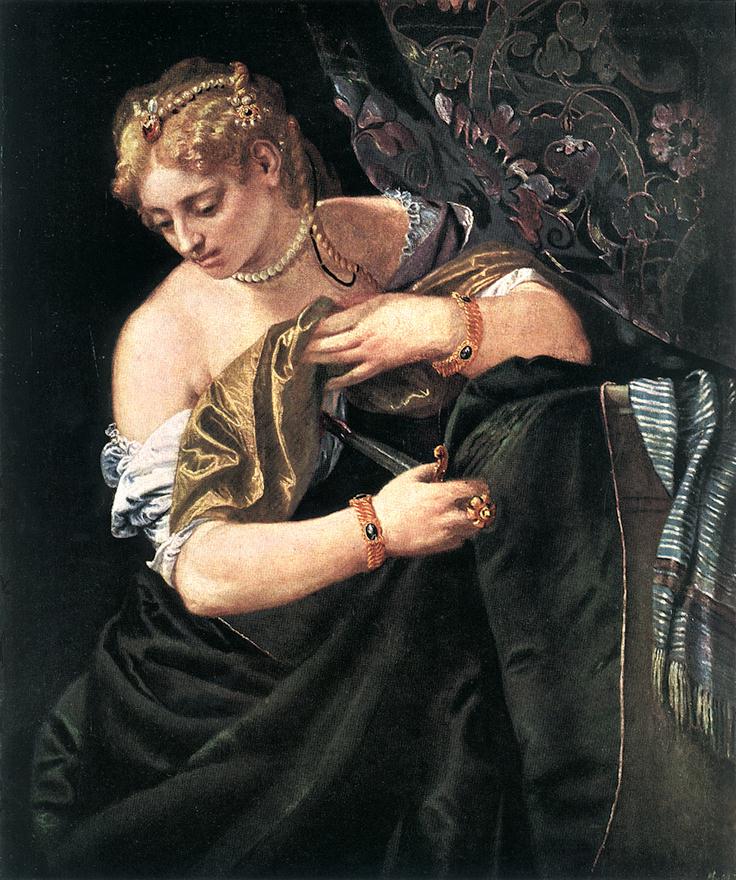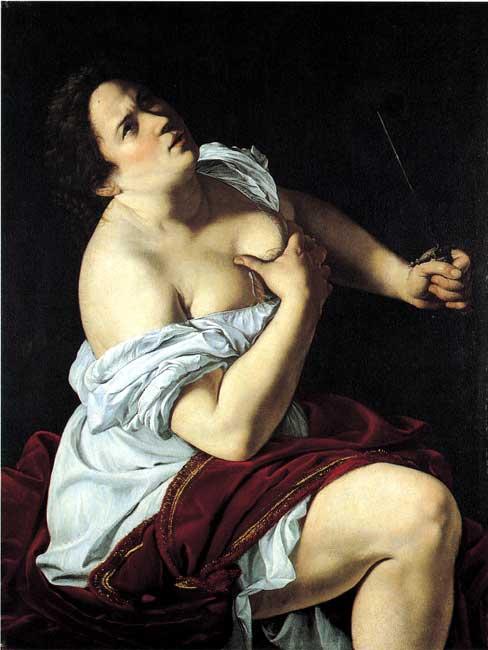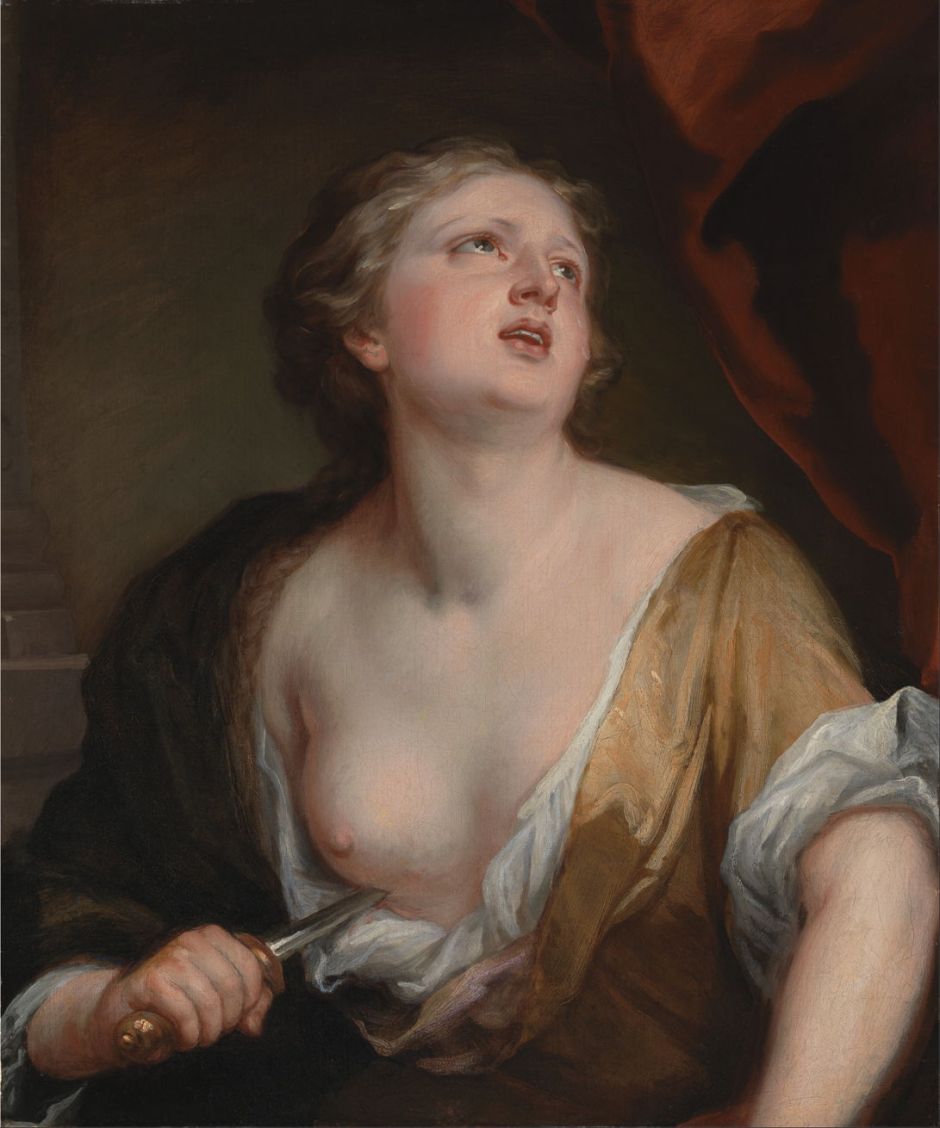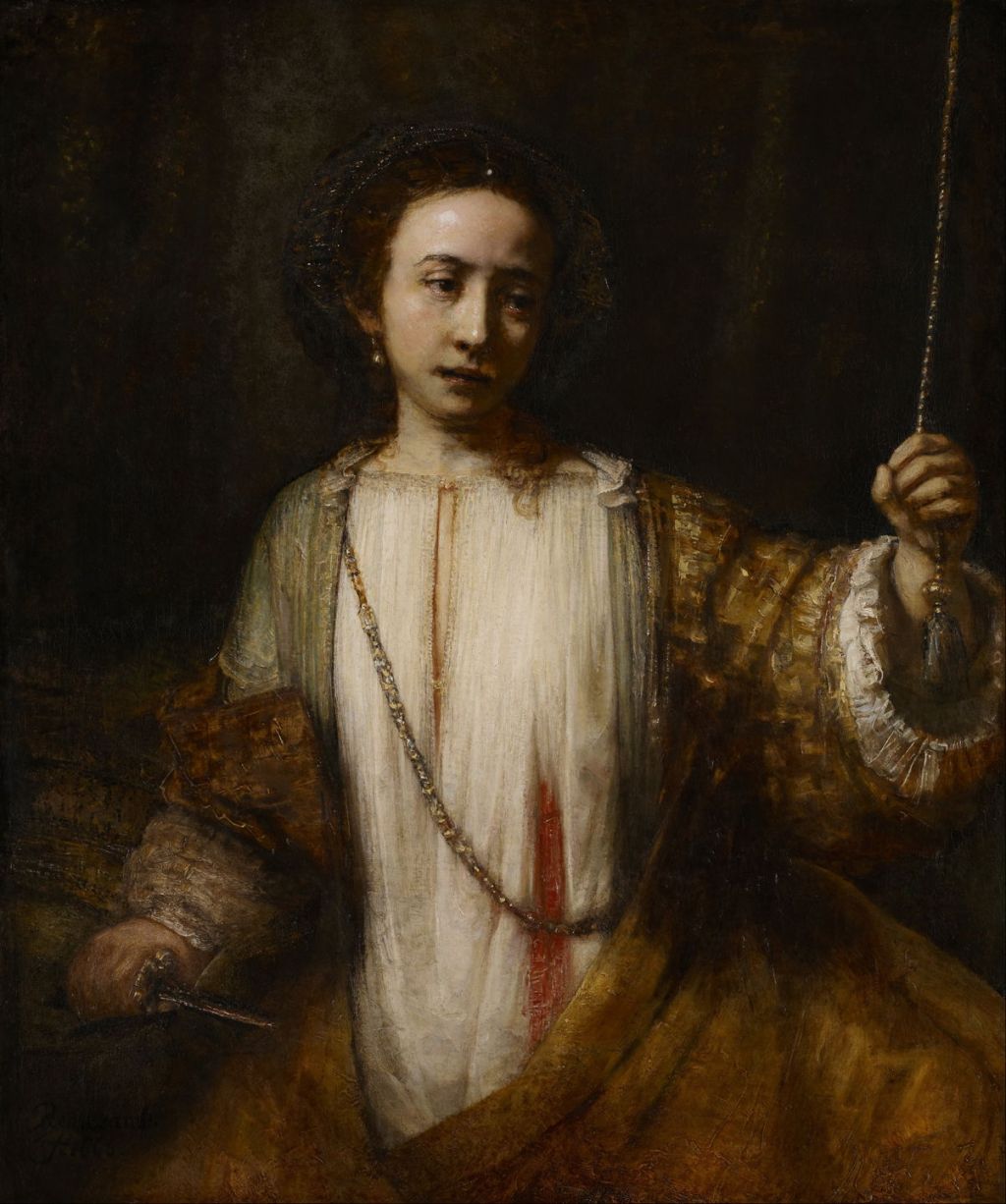Most narrative paintings involve figures, often lots of them.
Although not mandatorily so, the best narratives are about people, and we empathise most with human stories. Constructing a good narrative painting with a lot of people – whether it is the Last Supper, or the Rape of the Sabine Women – is complex, and they are hard to paint really well. But the greatest challenge to any artist is a narrative painting with just a single person, because that individual has to carry the whole story.
Text narrative
The story of Lucretia, who died by her own hand in 510 to 507 BCE, is well known. Various versions, all of which date from about 500 years later, contain slightly different details, so I will try to offer as much of a consensus as I can.
Lucretia, the daughter of Spurius Lucretius, the prefect of Rome and a “man of distinction”, was married to one of its consuls, Lucius Tarquinius Collatinus, who was the son of the king’s nephew. For whatever reason, Sextus Tarquinius, the son of Lucius Tarquinius Superbus the king of Rome (at that time Rome was still a monarchy), was being entertained by Lucretia and her household, her husband being away at the siege of Ardea.
At night, Sextus entered Lucretia’s bedroom, and offered her the choice of submitting to his sexual advances and becoming his wife, or he would kill her and one of her slaves, and claim that he had caught them engaged in adulterous sex. He thus raped her, and left.
The following morning she dressed in black and met with her father and witnesses, in front of whom she gave account of what had happened, and called for vengeance. While her father and the witnesses were discussing the matter, she drew a dagger and stabbed herself in the chest, dying in front of them.
Her husband returned, was distraught, and swore an oath on the dagger that he would overthrow the current king’s dynasty and end its tyranny. Those mourning Lucretia’s death swore the same oath on it, and Lucretia’s blood. Lucretia’s body was then paraded in the Roman Forum, and fuelled the overthrow of the king and Rome’s early monarchy, transforming it into the great republic which we know as the Roman Empire.
A story of passion, strong emotion, and gravity, this has been depicted in many paintings, with written accounts by Chaucer, Shakespeare, and many others. Benjamin Britten also wrote an opera The Rape of Lucretia, first performed in 1946.
Narrative paintings
The painter has an obvious choice of two scenes which might merit depiction: the rape itself, or Lucretia’s suicide. As an act of violence and violation, the rape has been very popular in the past, but many of the resulting images are themselves inevitably violent, violatory, and voyeuristic in the nastiest way. That particular part of the narrative also has weaker links to any broader historical importance.
Many of the existing depictions of Lucretia’s suicide are, frankly, graphic, gory, and superficial. I have chosen five, which are in my opinion among the best, and which show how a single figure can deliver rich narrative. They were all painted within the century from 1580 to 1680, using oil paints on canvas, and are of similar size.
Paolo Veronese (1528–1588)
(My apologies for the small size of this image.)
As he grew older, Veronese attained a maturity which enabled him to tackle highly emotive subjects, such as Judith and Holofernes (c 1580-5), painted at about the same time as his Lucretia. I find this one of his most moving paintings.

Veronese shows Lucretia in her funereal black robes, clearly in opulent surroundings judging by the rich but sombre drapes, with the dagger held at her breast. She wears fine jewellery, as would be appropriate for a woman of her status, and her hair is elaborately decorated with pearls and stones.
Her face is cast down, as if starting the collapse after she had thrust her dagger into her chest, its expression masklike, as death starts to overwhelm her. Her left hand holds her robes up above the dagger, which is grasped in her right hand. The viscid, dark blood covering the end reveals that it has already been thrust in, and has just been withdrawn. As she now crosses the threshold of death, she will fade back into the blackness of her robes, and the oblivion beyond.
Artemisia Gentileschi (1593–1653)
(My apologies for the very small size of this image.)
The daughter of a painter who became probably the finest of the successors to Caravaggio, Artemisia Gentileschi was herself raped by Tassi when a pupil of his. She then had to undergo the ordeal of his trial. Never afraid to tackle such challenging and emotive subjects, she is believed to have painted several versions of Lucretia. A later painting (from c 1630-5) may have been made by her, or Massimo Stanzione, but this version is distinctively hers.

She shows Lucretia with her robes in disarray, seated, and looking up. Her face is contorted, her brow knotted, and her lips pursed. She has none of the fine jewellery which might be expected, and her black garb is replaced by fabric the same dark red as congealing blood. She brandishes the dagger in her left hand, its blade pointing up into the air, but almost concealed in the surrounding black gloom. Her right hand grasps her left breast from underneath, pushing it upwards as if to clear the way for the thrust of the blade.
It is not immediately clear whether she has already driven the dagger into her chest: I suspect not, and that she is just about to make that final voluntary effort, in a swift arc with her left hand.
Rembrandt (1606–1669)
Having been fortunate enough to see both these paintings together, in the 2014 Late Rembrandt exhibition, I can guarantee that making the effort to see them both is very worthwhile. They are among the most moving of Rembrandt’s works, and I think two of the most emotive paintings ever created. Although painted just two years apart, in 1664 and 1666, and apparently using the same model, they are quite different in mood and narrative content.

In the earlier painting, Lucretia is seen just about to run the dagger home into her chest. Rembrandt dresses here in fine contemporary clothes, rather than the black robes of the story, and she is richly decorated with jewellery. She is seen facing the viewer, but her head is slightly inclined to the right, and she stares emptily at her right hand. Her face shows calm resignation to her fate, with a tinge of wistful sadness.
Her arms are outstretched, to the edges of the canvas. The left hand is grubby and held open, palm towards the viewer, perhaps protesting her virtue. The right grasps the handle of a dagger, which is just being brought around in an arc to impale her chest and bring her end.

The later painting is more remarkable still: Lucretia has already pierced her chest with the blade. Her fine clothing has been pulled back to reveal her simple white shift, which has a broad streak of fresh, bright red blood running down from the point at which the dagger was inserted.
Her arms are outstretched here too, but for very different purposes. The right hand still clutches the dagger, which has dropped to waist level already. Her left hand is dragging a beaded bell-pull, presumably to summon her family to witness her final moments on earth.
It is her face, though, which makes this painting. Her eyes, moistened by welling tears, are looking away to the right of the painting, in an absent-minded stare. Her brow is tensed with subtle anxiety. She knows that she is about to die, and is preparing herself for that moment.
Sir Godfrey Kneller (1646–1723)
This last painting was a surprise discovery to me. One of the few narrative works painted by the most prominent and successful British portraitist of the late 1600s and early 1700s, it is a far cry from his many depictions of the great and the good of the day. Painted in 1672-5, it follows from the paintings above.

Lucretia is here caught at the moment that the dagger is piercing her chest. She is not wearing the standard black robes of the story, but a plain dress which has been thrown open to bare her chest and right breast. Her head and eyes are cast up (in a posture similar to that shown by Artemisia Gentileschi), as if looking towards her destination in heaven. She appears tensed and anxious, and her mouth is part open as if she is gasping as the metal passes through the wall of her chest.
The dagger is gripped in her right hand, which is driving it into her body. Her left arm hangs by her side, inactive, and behind her is a deep red drape, reminding us of the blood which will soon run from her wound.
Conclusions
Each of these paintings captures the climax of the narrative in a simple but profoundly moving combination of facial expression, body posture, arm movements, and the fateful dagger. They show Lucretia on her own, her lonely decision made, resolving her inner conflict by ending her life. But in this narrative climax, it anticipates the resolution, in which Lucretia’s fearless defence of her virtue leads the Romans to defend theirs by deposing their tyrannical king, and becoming a republic. This guides us to the view that it was Lucretia’s self-sacrifice which inspired the whole Roman Empire.
There are of course lengthy symbolic and semiotic interpretations which can be made. The penetration of the dagger can be viewed as symbolic rape, and Bal and others have proposed lengthy readings which seem to move further and further from the original narrative.
However you wish to interpret each of these paintings, they make the clear point that narrative in paintings is strongest and most moving with simple images, uncluttered by elaborate cross-references to details of the text narrative, or multiple symbols – when it is painted by a great master.
I also note the almost complete absence of paintings showing Lucretia since 1800. I am disappointed that none of the innovative artists of the nineteenth or twentieth centuries felt that they could rise to this challenge of passion, strong emotion, and gravity in a painting.
References
Wikipedia’s excellent comparative account of the text narrative.
Favourite Paintings – Rembrandt
Favourite Paintings – Artemisia Gentileschi
Bal M (1991/2006) Reading Rembrandt. Beyond the Word-Image Opposition, Cambridge UP and Amsterdam Academic Archive. ISBN 90 5356 858 1.
Bikker J & Weber GJM et al. (2014) Rembrandt, the Late Works, Yale UP. ISBN 978 18 5709 557 9.
Locker JM (2015) Artemisia Gentileschi. The Language of Painting, Yale UP. ISBN 978 0 300 18511 9.
Salomon XF (2014) Veronese, National Gallery Co and Yale UP. ISBN 978 1 85709 553 1.
Schama S (1999) Rembrandt’s Eyes, Penguin. ISBN 0 14 028841 4.

